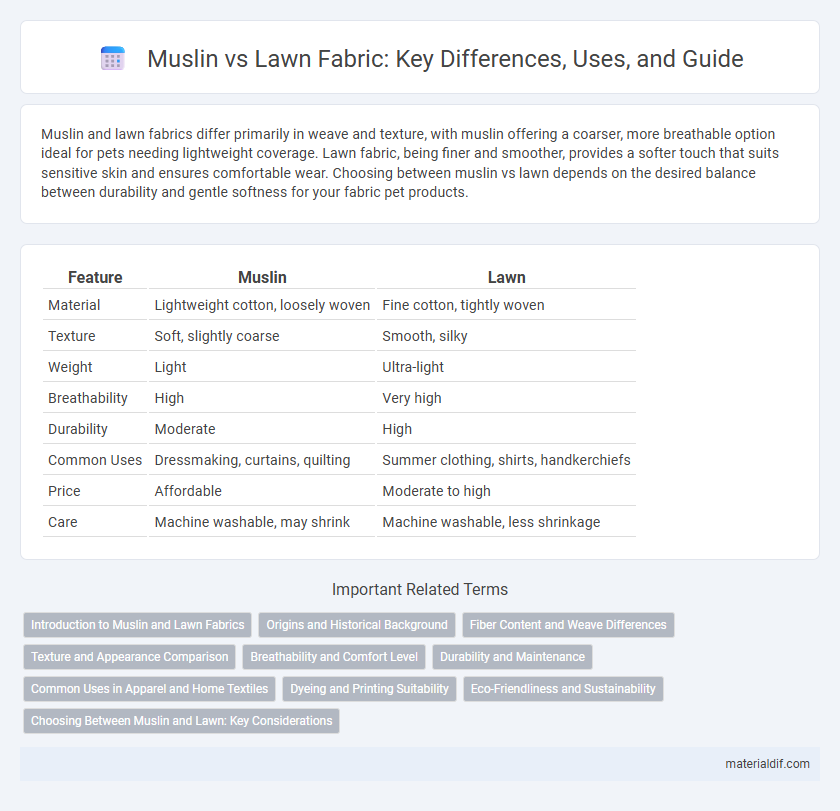Muslin and lawn fabrics differ primarily in weave and texture, with muslin offering a coarser, more breathable option ideal for pets needing lightweight coverage. Lawn fabric, being finer and smoother, provides a softer touch that suits sensitive skin and ensures comfortable wear. Choosing between muslin vs lawn depends on the desired balance between durability and gentle softness for your fabric pet products.
Table of Comparison
| Feature | Muslin | Lawn |
|---|---|---|
| Material | Lightweight cotton, loosely woven | Fine cotton, tightly woven |
| Texture | Soft, slightly coarse | Smooth, silky |
| Weight | Light | Ultra-light |
| Breathability | High | Very high |
| Durability | Moderate | High |
| Common Uses | Dressmaking, curtains, quilting | Summer clothing, shirts, handkerchiefs |
| Price | Affordable | Moderate to high |
| Care | Machine washable, may shrink | Machine washable, less shrinkage |
Introduction to Muslin and Lawn Fabrics
Muslin is a lightweight, breathable cotton fabric known for its soft texture and versatility in clothing and home textiles. Lawn fabric, also made from fine cotton yarns, offers a smoother, denser weave with a silky finish, making it ideal for delicate summer garments. Both muslin and lawn are prized for their comfort and breathability, yet lawn provides a slightly more refined appearance compared to the airy, slightly coarse feel of muslin.
Origins and Historical Background
Muslin, originating from the Bengal region of South Asia, dates back to the 17th century and was prized for its lightweight, sheer texture used in fine garments and home textiles. Lawn fabric, emerging later in the 19th century in Europe, is a finely woven plain weave cotton known for its smooth finish and crisp feel, often used in summer apparel. Both fabrics share a cotton base but differ in weaving techniques and cultural significance, reflecting their distinct historical and geographical roots.
Fiber Content and Weave Differences
Muslin fabric is typically made from coarser cotton fibers woven in a plain, loose weave, resulting in a breathable but less smooth texture. Lawn cloth features finer, high-quality cotton fibers with a tighter, plain weave that creates a smoother, silkier surface ideal for lightweight garments. Both fabrics prioritize cotton fiber content, but lawn offers superior softness and a more polished finish compared to the rustic, airy structure of muslin.
Texture and Appearance Comparison
Muslin features a coarser, open-weave texture that offers a rustic, matte appearance, making it ideal for casual and breathable garments. Lawn fabric boasts a finer, tighter weave with a smooth, silky texture that provides a slight sheen and crisp finish, perfect for lightweight, elegant clothing. The textural difference significantly influences the drape and overall aesthetic, with muslin appearing more natural and lawn giving a polished look.
Breathability and Comfort Level
Muslin fabric offers exceptional breathability due to its loosely woven texture, making it ideal for warm weather and sensitive skin. Lawn fabric, while also lightweight, features a finer, tighter weave that provides a smoother feel and slightly less airflow but enhances comfort with its crisp finish. Both fabrics excel in comfort, but muslin prioritizes airflow, whereas lawn emphasizes a silky touch and moderate breathability.
Durability and Maintenance
Muslin fabric offers moderate durability, making it suitable for everyday wear but requiring gentle care to prevent tearing and fraying. Lawn fabric, composed of finely woven cotton or linen, provides higher durability and resists wear better while maintaining a smooth texture. Maintenance for muslin involves careful hand washing or gentle machine cycles, whereas lawn fabric is easier to maintain with regular machine washing and less frequent ironing.
Common Uses in Apparel and Home Textiles
Muslin is commonly used for lightweight apparel such as dresses, shirts, and linings due to its breathable and soft texture, making it ideal for casual and summer wear. Lawn fabric, with its fine, smooth weave, is favored for high-end garments like blouses, dresses, and scarves, offering a crisp finish and elegant drape. In home textiles, muslin is often utilized for curtains and bedding because of its durability and breathability, while lawn is preferred for delicate furnishings like pillow covers and decorative textiles where a refined appearance is desired.
Dyeing and Printing Suitability
Muslin fabric, characterized by its coarser weave and natural texture, absorbs dyes effectively but may result in less vibrant colors and slightly uneven print details. Lawn fabric, known for its fine, smooth weave and high thread count, holds dyes with superb intensity, enabling sharp and detailed prints ideal for intricate patterns. Both fabrics respond well to dyeing, but lawn's smoother surface ensures superior print clarity and longevity in color retention.
Eco-Friendliness and Sustainability
Muslin fabric, typically made from 100% cotton, is renowned for its natural breathability and biodegradability, making it a highly eco-friendly choice compared to synthetic blends. Lawn fabric, often crafted from fine cotton or cotton blends, offers a lightweight texture but may involve more chemical treatments that can impact its sustainability footprint. Choosing organic muslin fabrics supports sustainable farming practices, while ensuring lower water usage and reduced chemical inputs compared to conventional lawn textiles.
Choosing Between Muslin and Lawn: Key Considerations
Muslin and lawn fabrics differ significantly in texture and breathability, with muslin being a loosely woven, lightweight cotton ideal for casual wear and layering, while lawn is a fine, tightly woven cotton that offers a smooth, crisp finish perfect for formal attire and summer dresses. When choosing between muslin and lawn, consider factors such as durability, drape, and comfort, as muslin provides a soft, airy feel suitable for relaxed styles, whereas lawn's refined surface enhances garment structure and elegance. Budget and intended use also play crucial roles; muslin tends to be more affordable and versatile for everyday garments, while lawn commands higher prices due to its delicate weave and premium appearance.
Muslin vs Lawn Infographic

 materialdif.com
materialdif.com